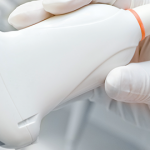
Africa Studio / shutterstock.com
An analysis of treat-to-target therapy assessing two ultrasound definitions of remission for patients with early rheumatoid arthritis (RA) has concluded that using ultrasound remission as a target was not associated with better long-term outcomes for RA patients.1
Compared with MRI, ultrasound costs less, is more accessible and offers the ability to scan more joints in a shorter period of time, but the benefits of structured ultrasound examinations in daily care if patients receive optimal treatment have not been demonstrated, says Siri Lillegraven, MD, MPH, PhD, one of the study’s senior authors and a resident in the Department of Rheumatology at Diakonhjemmet Hospital, Oslo, Norway.
The new paper is a secondary analysis of data from the Norwegian ARCTIC study (aiming for remission in rheumatoid arthritis: a randomized trial examining the benefit of ultrasound in a clinical tight control regimen), published in 2016.2 Starting in 2010, the ARCTIC researchers assessed 238 patients aged 18 to 75 who met ACR/European League Against Rheumatism (EULAR) classification criteria for RA, were naive for disease-modifying anti-rheumatic drugs (DMARDs) and were less than two years from first report of swelling joints to test whether incorporating ultrasound into their treatment strategy led to better outcomes.
One ARCTIC treatment arm, targeting clinical and imaging definitions of remission, incorporated a tight control ultrasound remission strategy using power Doppler and gray-scale assessment for 32 joints. The second arm used conventional tight control aiming for clinical remission. Both groups received a DMARD escalation strategy, with dose escalations based on Disease Activity Score (DAS) response in combination with change in ultrasound scores. Based on the findings, the researchers concluded the systematic use of ultrasound in follow-up of patients with RA according to current recommendations is not justified.
What Should Be the Target?
Treat to target is a dynamic treatment strategy that uses a specific testing goal to indicate whether treatment has achieved either disease remission—absence of signs and symptoms of the disease—or low disease state. Testing is done frequently, for example, every one to three months. If the target is not being reached, then medical treatments are changed or supplemented with new therapies. This approach encourages doctors to treat more often and more aggressively if the treatment plan is not producing desired results. For early RA, it is widely accepted as a way to achieve better long-term outcomes—with fewer symptoms and higher remission rates.
But there is less agreement on what the target should be—how remission is determined, Dr. Lillegraven notes. Multiple criteria are used in current clinical practice, including physical exams; radiographic evidence; and composite measures, such as DAS28 and the ACR/EULAR 2011 Remission Criteria for RA, which use Boolean or index-based criteria.3
“What we did in ARCTIC was to treat based on subclinical inflammation, assessed by ultrasound,” she explains. “The ARCTIC physicians and researchers hypothesized that follow-up with ultrasound was beneficial and would lead to better outcomes. But when we analyzed the results from using ultrasound as part of treat to target, there was no difference between the two groups, with or without ultrasound, in almost all parameters,” she says. The current secondary analyses instead supported the ACR/EULAR standard of Boolean (yes or no) remission in 44 joints as the preferred treatment target in early RA.
“We know ultrasound can be useful in diagnosing RA in early stages or in patients who don’t have swollen joints, but [do] have subclinical inflammation that can be identified by ultrasound.” It still has an important place in rheumatology practice, Dr. Lillegraven tells TR, but not necessarily on every doctor’s visit. “We haven’t stopped using ultrasound in our clinics as a diagnostic aid in RA. We still use it in our department, but no longer to detect subclinical inflammation in a treat-to-target setting.”

